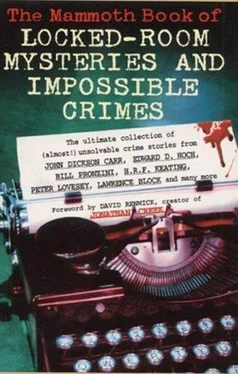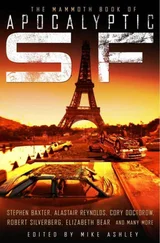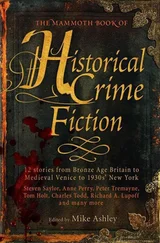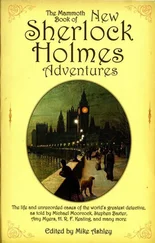Mike Ashley - The Mammoth Book of Locked-Room Mysteries And Impossible Crimes
Здесь есть возможность читать онлайн «Mike Ashley - The Mammoth Book of Locked-Room Mysteries And Impossible Crimes» весь текст электронной книги совершенно бесплатно (целиком полную версию без сокращений). В некоторых случаях можно слушать аудио, скачать через торрент в формате fb2 и присутствует краткое содержание. Жанр: Детектив, на английском языке. Описание произведения, (предисловие) а так же отзывы посетителей доступны на портале библиотеки ЛибКат.
- Название:The Mammoth Book of Locked-Room Mysteries And Impossible Crimes
- Автор:
- Жанр:
- Год:неизвестен
- ISBN:нет данных
- Рейтинг книги:3 / 5. Голосов: 1
-
Избранное:Добавить в избранное
- Отзывы:
-
Ваша оценка:
- 60
- 1
- 2
- 3
- 4
- 5
The Mammoth Book of Locked-Room Mysteries And Impossible Crimes: краткое содержание, описание и аннотация
Предлагаем к чтению аннотацию, описание, краткое содержание или предисловие (зависит от того, что написал сам автор книги «The Mammoth Book of Locked-Room Mysteries And Impossible Crimes»). Если вы не нашли необходимую информацию о книге — напишите в комментариях, мы постараемся отыскать её.
A new anthology of twenty-nine short stories features an array of baffling locked-room mysteries by Michael Collins, Bill Pronzini, Susanna Gregory, H. R. F. Keating, Peter Lovesey, Kate Ellis, and Lawrence Block, among others.
The Mammoth Book of Locked-Room Mysteries And Impossible Crimes — читать онлайн бесплатно полную книгу (весь текст) целиком
Ниже представлен текст книги, разбитый по страницам. Система сохранения места последней прочитанной страницы, позволяет с удобством читать онлайн бесплатно книгу «The Mammoth Book of Locked-Room Mysteries And Impossible Crimes», без необходимости каждый раз заново искать на чём Вы остановились. Поставьте закладку, и сможете в любой момент перейти на страницу, на которой закончили чтение.
Интервал:
Закладка:
First thing Monday morning Junior called me into his office and told me the tale, leaning back in his battered wooden chair until it looked like only an abiding faith kept it from falling over backwards, with his feet propped up on the well-scarred top of his desk. The front office at Continental Investigations & Security’s Los Angeles branch holds a reception area and several interview rooms, all done in well-polished light wood and glass, where our well-groomed lads and lasses listen sympathetically and nod and take notes and impress the hell out of our clients. The “back room” is actually three rooms; one a safe-room for our more confidential files, one with three couches and a small refrigerator and coffee machine for operatives who have to spend the night – or the week – and the third is Junior’s office. Abe Wohlstein Junior is older than sin and not at all presentable, but he knows everything there is to know and he runs the place.
After reminding me that Fiduciary Mutual Insurance was one of our larger accounts, and suggesting that I simulate an air of respect while dealing with them, Junior sent me over to Fid Mut’s Century City office to see a claims agent named Jamieson.
“It’s this old picture,” Jamieson said. “It’s disappeared. The way they tell it, there’s no way it could have gone, and there isn’t anyone who could have taken it, but it’s gone anyway.” A short, narrow, prissy-looking man with a thin black moustache above thin lips, he looked as though he was prepared to disapprove of me at the slightest provocation. But maybe that’s just the way he looked.
I lowered myself into the chrome and black chair by his desk. “The way they tell it?”
“Exactly. The way they tell it, it’s simply impossible.” He smirked. “But we know there’s nothing impossible, don’t we?”
I told Jamieson that I’d take his word for it, that epistemology wasn’t my field, and suggested that he get on with the story. He looked at me with a hurt expression, as though he had just been bitten by a pet guppy.
“The family is named Czeppski,” Jamieson said, playing tippity-tap on his computer keyboard and peering at the screen, “Graf Maximilian and Grafin Sylvia.” He turned to me. “Graf and grafin – that’s Polish for count and countess.”
“German,” I said.
“Whatever,” he said, looking annoyed.
“The Poles use German titles sometimes,” I said to mollify him. He didn’t look mollified. I stared out the wide picture window. We were on the 37th Floor. I could make out part of Santa Monica through the smog which stretched out in an unbroken layer below me. It was a brown smog day. I understand the green smog is more damaging to your lungs. They say the smog is getting better. They don’t say better than what. The sun was somewhere above, and I saw shadows below but no glitter. The smog ate the glitter.
“They’ve been in the United States for about six months,” Jamieson said. “There’s also a daughter named Paula. They left the painting in storage in Paris, and it was just shipped over to be auctioned. An old family heirloom that’s been buried in a barn for the past sixty years.” He scissored a Polaroid from the folder with two well-manicured fingers and handed it to me. It was a medieval-looking painting of a thin man in a dirty white robe with a halo that looked as if it originated in his left nostril and ended in his right ear. His hand was bent at an unnatural angle and pebbles were falling out of it onto a group of emaciated children below. The predominant colours were red, brown and gold.
“Interesting,” I said, “but is it art?”
“It should bring at least two million at auction,” Jamieson told me. “It is a fourteenth-century depiction of Saint Simon of- ah – someplace – feeding the children.”
“Pebbles?” I asked.
“Apparently he threw them stones, which miraculously turned into loaves of bread when they caught them.”
“I’ll bet he was surprised,” I said.
“The painting was authenticated before it left Europe,” Jamieson said. “It’s insured for one-point-two million. It disappeared last night from the Czeppski apartment. Graf Maximilian wants a cheque. I want to know how it happened – where it went.”
“You offering a reward?” I asked. A polite way of asking whether Fiduciary Mutual was willing to buy the painting back from the thieves. They always were unless they thought it was an inside job. Most insurance companies have the ethical standards of rattlesnakes without the rattles. They should be required by law to tie rattles on as a warning when dealing with claimants.
“Not just yet,” Jamieson said. “I assume they hid it somewhere. But the police did a thorough search and couldn’t find it. That’s why I called your office. You find it, then we don’t have to cut a cheque.”
“Let’s see what you’ve got,” I said.
CI &S does most of Fiduciary Mutual’s investigative work, so I was familiar with their procedures, even though I’d never worked with Jamieson before. They didn’t like hiring detectives, and they only did it when they were convinced that something was wrong. It was then our job to prove that something was wrong so they could justify the expense. If we actually found the painting, we’d be in line for a reasonable, but not excessive, bonus.
The folder held about a dozen pages of the sort of paperwork that corporations use to give everyone a feeling that no stone is being unturned. There was a copy of the original insurance application; an international form with all the questions asked in three languages above neat rectangular boxes just too small to write in the answers. The questions had been answered in English, I noticed, in a small, round hand written with a fine point fountain pen. We detectives notice details like that. There were copies of several documents which served to authenticate the picture: a letter from an art expert certifying, I suppose, that the painting was, indeed, art; a formal document on a kind of gridded paper of an odd size that detailed the tests that had been performed on the paint, establishing that it was at least five hundred years old; and a very formal letter from an art historian putting the painting in its proper place in the history of art. The first two documents were in French, the third in English.
The shipping documents showed that the painting had been packed and shipped by a firm picked by the insurance company, one that regularly did the same for entire shows for major art museums. There was a detailed diagram of the shipping crate. There was a document from the shippers certifying that they had turned the painting over to Graf Czeppski in the same condition as they received it. What I assumed was Czeppski’s signature was scrawled across the bottom.
I photocopied the three pages in the Czeppski folder that actually told anything about the Czeppskis, along with the four page police report, while Jamieson called the graf for me and made an appointment for three o’clock that afternoon. Then I headed to the Beechwood Cafe for lunch. It’s a piece of the old Hollywood that hasn’t been discovered by the tourists yet, so the locals tend to hang out there. There’s something soothing about eating surrounded by old writers and young actors. I studied the information on my photocopies over my natural sandwich with chunk white tuna. If there was anything there to tell me where the St Simon picture was hidden, I didn’t see it.
The Czeppskis had lived in Paris for over thirty years, since before daughter Paula was born. They had survived their years of poverty by doing an equestrian act in the Cirque Montmartre; horses cantering around the ring, graf and grafin cavorting on and off the horses’ backs. A few years ago, while the Soviet empire was busy crumbling, they had gone back to their ancestral estate outside of Szczecinek, a small town in northern Poland which was called Neustettin by the Germans when they thought they owned it. The estate had long since been carved up into pig farms, except for the chateau, which had housed a Soviet Army signals battalion. A little over a mile from the chateau the stable to the Czeppski horse farm, which had once held fifty horses, was still standing. Twenty-seven families lived in it now.
Читать дальшеИнтервал:
Закладка:
Похожие книги на «The Mammoth Book of Locked-Room Mysteries And Impossible Crimes»
Представляем Вашему вниманию похожие книги на «The Mammoth Book of Locked-Room Mysteries And Impossible Crimes» списком для выбора. Мы отобрали схожую по названию и смыслу литературу в надежде предоставить читателям больше вариантов отыскать новые, интересные, ещё непрочитанные произведения.
Обсуждение, отзывы о книге «The Mammoth Book of Locked-Room Mysteries And Impossible Crimes» и просто собственные мнения читателей. Оставьте ваши комментарии, напишите, что Вы думаете о произведении, его смысле или главных героях. Укажите что конкретно понравилось, а что нет, и почему Вы так считаете.










